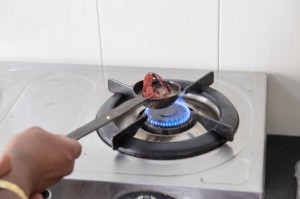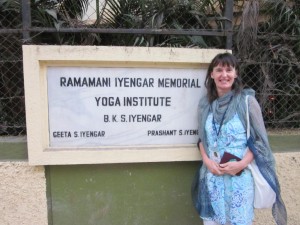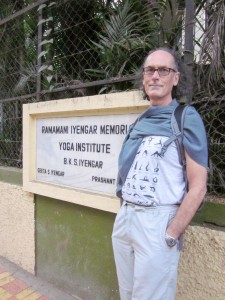27th December 2014
You’ll remember that Prashant said the cook was the closest to the path of YOG. Today we were really lucky to go to Talya’s house and learn how to cook. Talya is an ayurvedic cook who lives in Santa Cruz and has become a good friend, she arranged for us to have a cooking class in the old little Indian house she stays in from a very well thought of cook in Pune called Pradnya. Tasting the most extra-ordinary things. These are the ingredients for dosa chutney a beautiful coconut dish normally served on the side of a dosa to provide a special taste. We had this with rice and it was one of 4 chutneys made fresh for us. We had 7 dishes in all. To give you a sense of the ingredients; here they are for 1 dish the dosa chutney
ground nut
fresh coconut
ginger
tamarind
fresh chilies
black gram dal
oil
the magic ingredient:asafoetida heated in oil
and of course for us a bit too much sugar and salt!
Today has just turned out to be one of those incredible days. After experiencing some wonderful food, we met Pradnya’s son Pranjal a musician who offered to help us purchase a harmonium. I’ve been interested in the instrument for some years to play and sing. So after practice they both met us at the institute and took us in their car along extremely busy roads to a very old music shop beyond Deccan, towards Laxmi Rd and there we started to improvise, him on the harmonium and using his voice and me on voice too – a truly marvelous experience!!
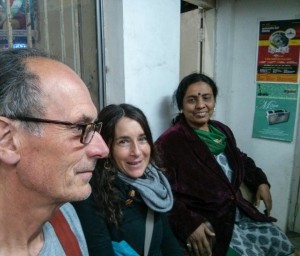
Here is Geoffrey Talya and Pranjal’s mum waiting in the music shop.
Lulled into a sense of stability here in our little flat in Pune, and of course excitement at the potential of new music I’ve now purchases one too many items! I bought the harmonium! It’s an instrument that produces drones, and notes – mine are arranged over 2 octaves, and it uses bellows that we operate drawing in and out. It sits classically like a box on the floor or here in on the shop counter and one plays it to accompany the voice. So now there is a difficult decision, shall we try to transport it with us so that I can practice, or shall we ship it back to the UK. It’s 13 KG. And of course we have the yoga equipment we had to purchase for the big convention: 8 blankets, and 2 bricks plus of course a new wardrobe as I brought only clothes for leaving and arriving back in the UK.
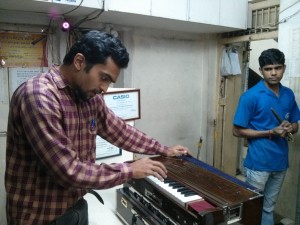
This is Pranjal accompanying our voices on another harmonium in the shop, whilst they were making a box for mine
I’d set out thinking I’d like to have this instrument some years ago, but what finally made it possible was Pranjal – he is a great singer, in fact a pop star with a fan club here in India. He’s in his 20’s and dedicates his material to one activist who was as important as Gandhi in the liberation of India back at the turn of the century. To cut a long story short we really hit it off musically and spent nearly 2 hours improvising in the Harmonium shop – with one of their instruments, so now we’re making plans to record some new material – it’s so fascinating to explore different modes and scales, Pranjal naturally sings the India ragas and devotional tunes, his mother is a classical Indian singer so he has grown up with these things and yet his ear is tuned to new music too. I somehow weave around them and bring in Celtic themes, sing even in Welsh and we both use open vowel sounds it all seems to work as a whole. We have an audience building of around 15 people hovering in and out of the shop, potential purchases, men with tools, and tickets and of course Geoffrey, Talya and Pradnya. It’s immersive and I got lost in it totally
Mind you, it was interesting that Pradnya said she went to England once but couldn’t cope with it because it was too quiet!It’s very hard to describe the constant noise of people and machines and birds here.
Afterwards we went on to his grandparents old house and ate a lovely sweet, that tasted like rose water, almond halva/turkish delight, then we sat and watched some footage of his band reaching celebrity status on Indian TV.
Well it’s coming towards the end of our time at The Ramamami Memorial Iyengar Yoga Institute Pune with only 2 classes left. Next Tuesday 30th is our last day and I feel sad about that.
On friday evening was our last Pranayama class with Navas, one of the most transparent and extra-ordinary teachers of the subject, her knowledge of anatomy and what happens is so transparent and she had built us up over 3 sessions so we understood.
Navas explains, like Geetaji did that we must bring our chin down in Pranayama, we may have it up for meditation but never for Pranayama.
She has this way of toning us through the stages which helps enormously, for example intoning a drone and the word ‘inhale’ quite quickly and rhythmically as we fill the lungs for:
Ujjayi 3 cycles supine
inhale,inhale,inhale,inhale, inhale, inhale (and then said strong and clear) ‘WAIT’
Ujjayi 4 cycles supine
exhale, exhale, exhale, exhale, exhale, exhale WAIT
Ujjayi 7 cycles seated)
inhale,inhale,inhale,inhale, inhale, inhale (and then said strong and clear) ‘WAIT’
Ujjayi 8 seated
exhale, exhale, exhale, exhale, exhale, exhale WAIT
For Viloma Pranayam her rhythmic tone changes
Supine then seated
‘inhaaaaile’ WAIT, inhale WAIT, inhale completely WAIT (going to 3 inhalations maximum, perhaps 4)
exhaaaaale WAIT, exhaale WAIT, exhaaale WAIT
In the seated pranayam we must think of the chest going up and the chin coming down, Navas said the Iyengar described the chest and chin meeting like the beloved meeting the beloved on an equal basis. It’s equal, one does not hang back. And on the top of complete inhalation as we WAIT, Navas describes that we hold a powerful energy in our chest for those few moments.
Today, like all the Saturdays Prashants group is much smaller, this is because the women have the chance to attend a later class instead of Prashant’s. So with only around 40 in the room instead of the usual 100 or 120 one can really get up close. Unusually we got there 15 minutes early, it was still dark outside and still quiet a part from the clamor and chatter of birds: the Coucal’s, the parakeets and the crows to name but 3.
In Prashant’s Pranayama classes, in fact all of his classes, he explains that he is far less directive. That as beginners we have to get into the culture of doing what we are told, and waiting for the teacher to say before we do – of course he only means subtle actions. But at some point the waiting for instruction needs to stop and we need to start tuning into a spontaneous process of our own, we could think of this in terms of the body speaking to us. Following it’s direction. Prashant says that YOG is spontaneous not instructional.
So in the first 30 minutes of class we work supine with a bolster and blanket, supta baddha konasana first, interspersed with rope sirsasana. Geoffrey is quite happy to spend serious amounts of time in this pose, and I’m getting to enjoy it. I think the free hanging ropes make a difference. This preparation work helps us get in touch naturally with the Uddiyana bandha. This means that while breathing, the pelvic floor and the belly are drawn inward and upward so that the breath is directed into the upper chest, we learn to expand the lower chest first, then the middle rib cage, and finally the upper chest. We also explore this is supta virasana, supta svastikasana etc, and we notice how the bolster supports access to Uddiyana Bandha and to the actions. Prashant reminds us that for beginners the bolster is there primarily to help us open the chest, but this is not the case for advanced students, the bolster then supports the body on a downward slope allowing the abdomen to descend down as we discover and get access to the abdomen. Without that we cannot discover pranayama. Rope sirsasana is very helpful here as this asana itself means that the abdomen moves back towards the spine naturally.
So after some time preparing the ground, to set right the breathing, we move to the inhalation, working in clusters of inhalations, increasing our awareness of the depth of one of the plethora of Uddiyana Kria movements with each breath: mild, stronger, extra strong etc.
After this practice we begin to find the transition between inhalation and exhalation, at thew end of the exhalation pause and as though we were excavating the breath inside the body we draw the bandha in and up, to take in the inhalation. For our next phase, we take the Uddiyana Kria off the exhalation and continue to increase it for inhalation. Like this, one begins to notice that there is a natural point where the inhalation stops, it can’t go further with this bandha in place and Prashant stops us to talk about how important this is. He talks about greed and wealth, how for some people 1million rupees is still not enough and that we want more and more and more. For others 1 thousand rupees is enough, for yoga people we can go wrong if we think more chest opening, more ego more breath, more and more and more of everything. And so we learn this lesson with the breath, we experience a point where we cannot go further, the inhalation stops because Uddiyana Bandha is in place, we cannot want more and more and more. This is an important lesson.
Prashant always suggests we stop once we’ve done a few rounds to notice the affects and become aware of the experience.
Later we lie without the bolster under us, just under our knees and we are encouraged to explore a different mode changing the amplitude, volume, density and the breath becoming softer, finer and more subtle. It’s very soothing and quiet.
From here we begin to explore un-sounded, silent utterances of speech on the exhalation. The most fundamental sound the source of the world is AUM which consists of 3 difference mantras/sounds; A or ‘un(cle)’ ‘U’ (fool) and ‘M'(ummmor gum). These sounds were used in vedic rituals, and are a little like our 5 vowel sounds but each sound accesses a different area of the consciousness. A is felt in the abdomen, U is felt in the chest and M is felt in the head. This is a vast subject and one I’m very interested in exploring. The affects on the brain of silent speech. Prashant suggests we go home and try making the sound and then once the heard sound has gone quiet to continue for a few moments as though still making the sound. This takes us towards the end of the exhalation, the act of doing this silent speech occupies our brain and certainly helps us focus. This moment at the end of the exhalation is very important, and we might be able to experience it more fully without distraction when we have the aid of silent speech.
There is a sense that Prashant is building our knowledge step by step and today in class we took another big step in learning and a whole world opened up through this silent speech.

